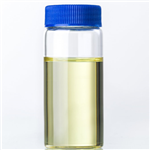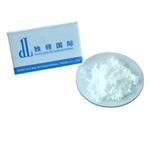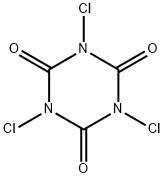Introduction of Trichloroisocyanuric acid
General description
Trichlorocyanuric acid, dry appears as a white slightly hygroscopic crystalline powder or lump solid with a mild chlorine-like odor. Said to have 85 percent available chlorine. Active ingredient in household dry bleaches. Used in swimming pools as a disinfectant.1,3,5-trichloro-1,3,5-triazinane-2,4,6-trione is a member of 1,3,5-triazinanes and an organochlorine compound. Trichloroisocyanuric acid is an efficient oxidant, disinfectant and deodorant. It has a strong killing effect on virus and bacteria. As a disinfectant, it is widely used in industrial water, swimming pool water, hospital water, etc. At the same time, it is also a good chemical synthetic raw material and a good organic synthetic catalyst. It is widely used in alcohol oxidation reaction. Trichloroisocyanuric acid has a broad market application prospect. The market demand is increasing year by year. The output of trichloroisocyanuric acid in China is also expanding. At the same time, the amount of waste water and waste gas brought by the production of trichloroisocyanuric acid is also increasing, and the impact on the environment is also increasing.
Application
Trichloroisocyanuric acid are strong disinfectants and bactericides. They are also Chlorinators and oxidants in chemical production. They are efficient, fast, broad-spectrum and low toxic disinfectants, which can effectively and quickly kill all kinds of bacteria, fungi, spores and molds. These products are widely used internationally as disinfectant and bactericide products, which are used in industrial water circulation treatment, food processing, daily chemical industry, medical and epidemic prevention. Trichloroisocyanuric acid (TCCA): an efficient green reagent for activation of thioglycosides toward hydrolysis:Trichloroisocyanuric acid (TCCA), an inexpensive, commercially available, and non-toxic reagent has been used for the activation of thioglycosides toward their hydrolysis to the corresponding hemiacetals in high to excellent yields. The methodology provides a mild reaction condition for dealing with compounds containing acid sensitive functional groups[1].
Figure TCCA(Trichloroisocyanuric acid) mediated conversion of thioglycoside to the corresponding hemiacetal.
Synthesis
The industrialized production method of green and environmental friendly trichloroisocyanuric acid is particularly important. After years of efforts, Jiheng chemical has finally successfully developed a new process for the production of trichloroisocyanuric acid with dichlorous oxide as chlorination agent. In the first step, the mixed gas of chlorine and air reacts with sodium carbonate powder containing a certain amount of water in a fluidized bed to produce dichlorous oxide. The reaction is a gas-solid reaction without a large amount of solvent as the medium, and the operation is simple. In the second step, dichlorous oxide enters the synthesis kettle after purification and reacts with cyanuric acid floating solution to produce the product trichloroisocyanuric acid. The centrifugal mother liquor is the saturated liquid of trichloroisocyanuric acid. It has no impurities such as sodium chloride and can be recycled. Compared with the traditional process, there is no follow-up treatment, which saves water resources, reduces production cost and reduces the pressure of environmental protection.[2,3]
Storage and Safety
Decomposes at 225°C. Moderately toxic by ingestion. May irritate skin and eyes. Precautions 1. It is forbidden to use metal containers to prepare solutions and not to use them together with alkaline substances; 2. After 1000 times dilution, the whole tank shall be sprinkled evenly. Excessive local drug concentration is strictly prohibited; 3. The dosage of seedling breeding pond shall be halved, the water body shall be thin, and the dosage shall be reduced when the transparency is higher than 30cm; 4. The application of medicine should be carried out in the morning of sunny days. It is forbidden in case of hypoxia, floating head and abnormal weather. The traditional trichloroisocyanuric acid wastewater treatment process was improved by increasing dechlorination efficiency under vacuum conditions, using hydrogen peroxide to reduce free chlorine without introducing other atoms. Through the combined treatment of chlorine oxidation and membrane filtration, the cyanuric acid mass concentration in the wastewater was reduced to less than 5 mg·L-1, and the total ammonium mass concentration was less than 2 mg·L-1, which met the water intake requirements of the electrolysis device and realized the recycling of wastewater[4].
Reference
1.Basu N., Maity S. K. & Chaudhury A. et al., "Trichloroisocyanuric acid (TCCA): an efficient green reagent for activation of thioglycosides toward hydrolysis," Carbohydrate Research, Vol.369(2013), pp.10-13.
2Wang Pingsheng, Xu Yongyu, Fu Zhenbin, etc.: new process for preparing trichloroisocyanuric acid with dichlorous oxide as chlorination agent, 2019.
3Ma Yunhai: method of producing trichloroisocyanuric acid in one step and two stages, science and technology information, 2008, issue 09, page 18.
4.Cheng Xiaodong, Ma hexu, Ma Chuanjun, etc.: treatment of trichloroisocyanuric acid wastewater, contemporary chemical industry, 2021, No. 04, pp. 993-995.
);You may like
See also
Lastest Price from Trichloroisocyanuric acid manufacturers

US $1.00/g2024-04-25
- CAS:
- 87-90-1
- Min. Order:
- 1g
- Purity:
- 99
- Supply Ability:
- 20tons

US $30.00/kg2024-02-27
- CAS:
- 87-90-1
- Min. Order:
- 1kg
- Purity:
- 99%
- Supply Ability:
- 20 tons
